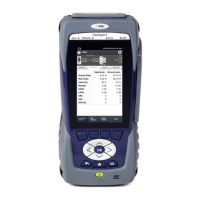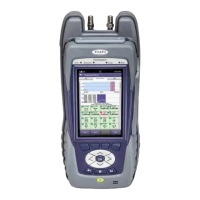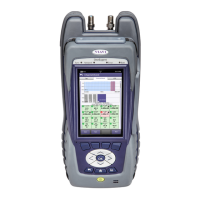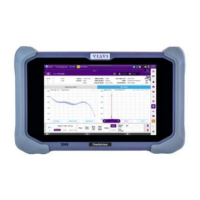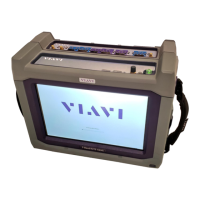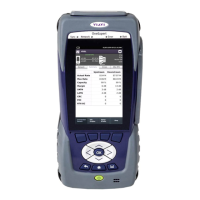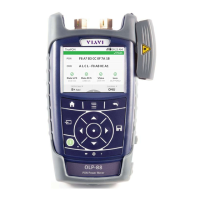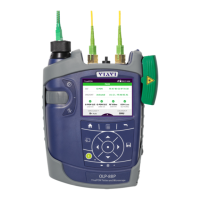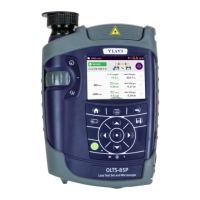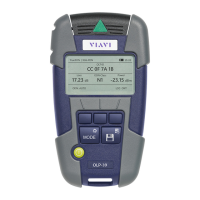Do you have a question about the Viavi OneExpert DSL ONX-580 and is the answer not in the manual?
Explains the manual's objective and coverage of OneExpert DSL features, warranty, services, and repair.
Provides contact information and website for technical support.
Explains formatting conventions for user interface actions, code, and text.
Explains the meaning of symbols used in the guide, such as general hazard and hazardous voltages.
Defines safety terms like DANGER, WARNING, CAUTION, and ALERT with their implications.
Provides a general overview of the OneExpert DSL as a modular test platform for service providers.
Lists key features like multi-touch UI, connectivity options, and various testing capabilities.
Explains initial setup steps, including inspecting for damage and powering on the instrument.
Describes the procedure for securely attaching or removing test modules from the base unit.
Details the controls and indicators on the front panel for operating the OneExpert DSL.
Explains the function of Sync, Network, Error, and Batt indicators on the front panel.
Explains how to navigate the instrument's intuitive touchscreen interface.
Describes the process of entering text or numbers using the on-screen keypad.
Describes the procedure to reset the OneExpert to its factory default settings.
Covers establishing wired and wireless network connections for updates and remote control.
Explains how to update the instrument's firmware using wired, WiFi, or USB connections.
Details how to synchronize the instrument with the StrataSync server for data management.
Explains how to create and generate test reports based on configuration and test results.
Introduces remote operation capabilities via Virtual Network Connection (VNC).
Explains the purpose of DSL tests to assess signal quality and data rates.
Describes how to specify the test mode, such as Single or Bonded xDSL.
Covers configuring DSL interface, vendor, technology, annex, and profiles.
Provides instructions for connecting to single or bonded twisted pairs for testing.
Explains how to run a OneCheck DSL test and interpret results for pass/fail indication.
Explains Ping and Traceroute tests for verifying connectivity to IP addresses or DNS names.
Details the TrueSpeed test for resolving network performance issues and evaluating customer experience.
Describes the Speed Check test for downstream and upstream throughput via Ethernet or xDSL/G.fast.
Introduces IP video testing features for verifying video service quality.
Explains VoIP testing features for emulating a VoIP phone and placing/receiving calls.
Introduces Ethernet TE mode for emulating Ethernet terminal equipment and testing connectivity.
Explains how to match instrument settings to the line and network configuration for testing.
Provides instructions for connecting the OneExpert to the line for Ethernet tests.
Explains how to run a OneCheck Ethernet test and compare results to thresholds.
Explains tests for mapping cables/wires and calculating cable length.
Describes using the Ping Tool to verify connectivity to network resources and IP addresses.
Describes using the microscope accessory to view fiber connectors and analyze cleanliness.
Explains how to use the Optical Power Meter to measure optical power at specific wavelengths.
Describes how to scan for WiFi networks and view SSIDs, signal strength, and channel.
Introduces the WiFi Coverage Expert for building reports about site WiFi performance.
Details how to troubleshoot network issues using the WiFi Coverage Expert.
Covers registering, unregistering, and managing WiFi Advisor devices.
Details how to register and locate up to 16 SmartIDs on the network.
Describes the Coax Map test for mapping coax network topology and identifying events.
Introduces copper testing features for quick turn-up and basic troubleshooting.
Explains how to control a far-end device (FED) for two-ended pair testing.
Describes how to measure AC and DC voltage using the multimeter function.
Explains how to measure resistance and leakage to identify shorts, grounds, and faults.
Describes using Time Domain Reflectometer (TDR) to identify and locate cable faults.
Explains how to run a OneCheck Copper test for pair quality and fault identification.
Explains how to enable the Fiber Inspection test to check connector cleanliness.
Describes tests for checking fiber connectors and monitoring fiber connection power.
Describes running fiber measurements using VIAVI Smart OTDR connected via WiFi.
Explains how to pair the mobile device and control the OneExpert DSL via Bluetooth.
Describes results available in DSL mode, including connection statistics and signal parameters.
Lists various error types like FEC, CRC, LOS, and SES with their meanings.
Introduces results for VoIP mode, covering Summary, QoS, MOS, and Network results.
Describes analysis of video streams, covering network status, bandwidth, and stream statistics.
Describes copper test results, including AC voltage, DC voltage, resistance, and leakage.
Explains how Time Domain Reflectometer (TDR) is used to identify and locate cable faults.
Describes common problems and solutions for the OneExpert, categorized by test type.
Lists physical, connector, environmental, and power specifications of the OneExpert DSL.
| Brand | Viavi |
|---|---|
| Model | OneExpert DSL ONX-580 |
| Category | Test Equipment |
| Language | English |

